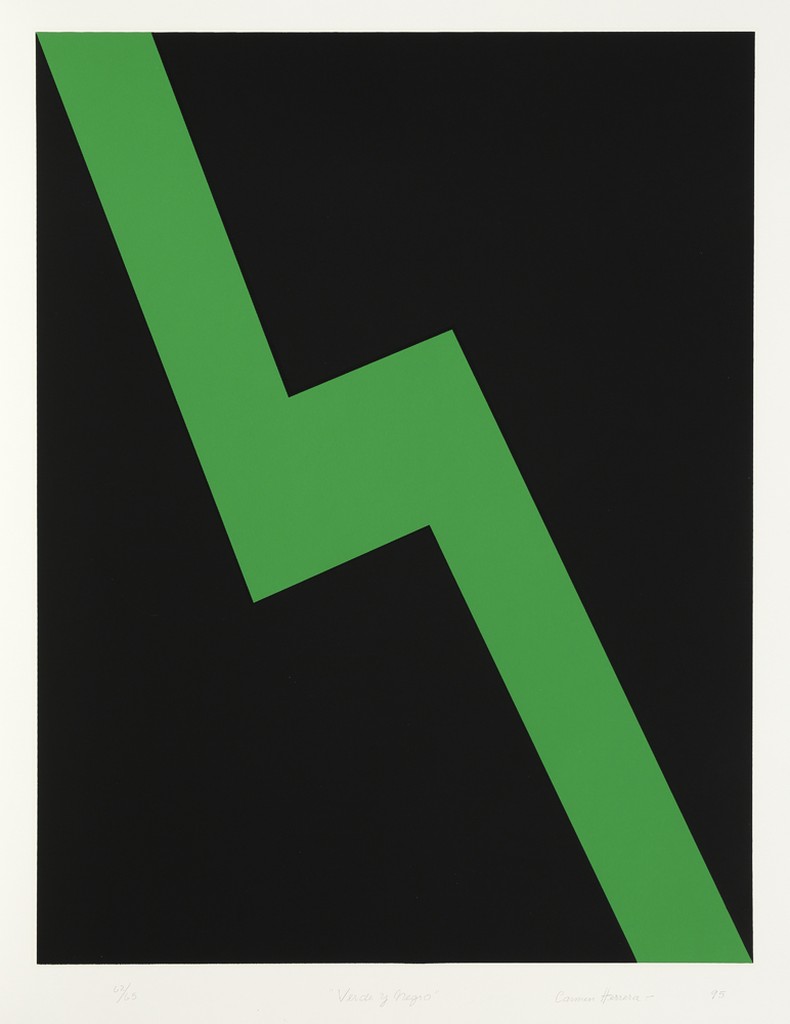
Every morning, promptly at 9:30 AM, Carmen Herrera looks out the window of her studio in New York City and begins to sketch. Her creative process is meticulous and orderly, just like the art she produces. After the initial sketch, Herrera transfers the concept to a piece of parchment paper and does the sketch again, this time with color. She then creates a larger version to ensure that the idea translates to a bigger size; if all looks good, her assistant begins to map out the lines onto a canvas. Finally, she paints.
In Herrera’s own words, she likes to paint order into a world of chaos. This chaos might refer to the hustle and bustle of New York City, but it could also refer to the many changes she underwent throughout her life. Herrera was born in Havana, Cuba in 1915. She began painting at a young age, and attended a school in Paris at 14 to continue her education. She returned to Cuba to study architecture, which influenced the art she made for the rest of her life. In 1939 she moved to New York with her new husband; shortly after, she again moved to Paris, where the couple lived for five years. During this period, she met several international artists and was exposed to new styles of art that went against her former training. After this, she returned to New York, where she continued to create for years to come.
All of Herrera’s art is of the geometric abstraction movement. She was among the earliest painters to create in this style in America; however, because of the lateness of her discovery, she was never credited as such. Herrera faced two large obstacles hindering her from recognition: not only was she a woman in art, she was also a Cuban in America. Even today, after living in New York for over 50 years, her success is somewhat focused on her being a Latin American artist.
When looking at Herrera’s work, it is important to remember that she was trained as an architect. She uses measurement and calculation to create the lines and angles that often feature in her work. Her work is characterized by “bold simplicity;” most of her pieces contain just two colors, specifically paired together. Sometimes her paintings represent the natural world in an abstract manner, but more often than not, they merely examine the “world of straight lines,” the beauty of which Herrera claims keeps her going, and keeps her creating.
Abstract art does not require a deeper meaning. Indeed, Herrera consciously refrained from politicizing her work or relating it in any way to her Cuban background. This brings us to Verde y Negro, the piece at hand. The print, which has dimensions of 35 x 27 inches, was created quite recently in 1995. It is composed of a perfectly centered single bolt of green against a black background. To be quite frank, it doesn’t initially seem like there is much to say about the piece. I would argue that Verde y Negro is not a representation of anything in particular. It is merely an examination of lines, as so many of Herrera’s pieces are. Verde y Negro is the result of a diligent and refined creative process- it looks simple enough, but upon closer inspection, one can imagine the measurements that had to take place to create it. All of the angles created by the sharp turns of the line are right angles; additionally, the width of the middle section of the line is equal to the length of the lines that contain it. This piece stood out to me out of the entire LUAG collection. I found it to be very striking and unique, but more than being drawn into the art itself, I was immediately curious about the artist who created it, and what the rest of her work might look like.
I think the most interesting thing about Herrera’s work is that it does not have to represent anything. Her work is more of a careful study, one that has been ongoing for the majority of her life. This May, Herrera turned 105 years old, and she still works every day. The amount of art she has created is almost unimaginable. Her story is unique, inspiring, and a testament to the benefits of dogged persistence.
(The main source used for this research was the short documentary created about Carmen Herrera, titled The 100 Years Show.)